Pullenvale State School will be celebrating our 150 year anniversary in 2024.
You may enjoy reading about our school History...
Thank you to Mr Fred Hardman, past Principal and Dr Ron Tooth, Principal Pullenvale Environmental Centre (PEEC) for this information.
The Pullenvale State School opened its doors for the first time on March 16th
1874 in what would have been a remote backblock of the Brisbane Colonial
settlement.
In
those days a telephone would have been the height of technology and certainly
beyond the reaches of the Pullenvale State School or the band of mainly
Scottish selectors who made up the parent body. One wonders how the original
Principal, Mr. George Henry Francis, would have marvelled at the internet site
we have today.
What
was one of the last one teacher schools on the outskirts of Brisbane right up
until 1978 has now developed to the present size of 420 students. This is
obviously a big change from the early days but what we will strive not to
change is the friendly country atmosphere that has always been synonymous with
Pullenvale and has always attracted people.
The Early Years
Pullenvale lies within a small,
shallow valley bound by an arc of rocky hills peaking at Mt Elphinstone. Its
eroded valley walls and floor guide Pullen Pullen Creek along meandering
pathways to the Brisbane River.
When Pullenvale was part of the
Jagera's tribal lands, grassy woodlands fringed the valley's tall forests pf
eucalypt, box and pine. Its sheltered slopes and damp gullies carried
subtropical rainforest where cedar beech and silky oak rose above tangled vines
and ferns. Artefacts, middens and bora rings found in the area indicate its
significance as a ceremonial meeting place and bountiful source of food and
fresh water.
Surveyor John Oxley was the first
European to recognise the potential for a free settlement in the Moreton Bay
hinterland. During his 1823 survey of the Brisbane River, Oxley described Mt
Elphinstone as Rocky Knob and noted the adjacent stand of good timber and open
grazing lands.
Oxley's primary task however, was to
choose a location for the new Moreton Bay penal colony. Construction began at
Redcliffe in September 1824, but eight months later the settlement was moved up
river near the present Victoria Bridge. On 11 February 1842 the penal colony
was closed and the region declared open to settlers.
Initial restriction on land
acquisition in the immediate Brisbane hinterland were lifted with changes to
the Land Act in 1846. Leasehold sections of one square mile became available
and lessees were given pre-emptive rights to convert to freehold. Settlers now
had access to land in the Moggill district which included the present suburbs
of Brookfield, Upper Brookfield, Pullenvale, Pinjarra Hills, Anstead,
Bellbowrie and Moggill.
Darby McGrath appears to have been
the area's first leaseholder, taking up land along Moggill Creek around 1848.
Further changes to the Act saw Job Twine purchase freehold title to Potion 1 at
Pullen Pullen Creek in February 1850, while Darby's brother, John, bought
Portion 19 at Moggill Creek in July. All three increased their holdings during
the 1850s as did John Doyle and Thomas Prior.
Timber resources sustained the
district in its infancy. For over 30 years bullock teams hauled logs from
Brookfield and Pullenvale to the Moggill Creek rafting ground. The logs were
chained together, rafted half a mile downstream to the Brisbane River, then
floated or shopped to Brisbane sawmills.
Many of Pullenvale's future
residents arrived in the colony between 1862 and 1868 but few could afford the
large tracts being offered. With the Crown Lands Alienation Act of 1868,
smaller holdings became available in the Parish of Moggill. Conditions under
the Act were generous with minimal leasing costs and conversion to freehold
providing improvements were made and the lessee resided on the property for a
specified period.
A Pioneering Community
The pioneering families of the
1860s and 70s formed a close-knit community; some having common
homelands, others meeting enroute to Australia. They shared the hardships
of creating a better life in a new and strange land.
Selectors felled and handcut
timber for stockyards, barns and their first homes which were
shingle-roofed, slab huts. Land was cleared for livestock and small crops
wit Brisbane Town providing a ready market for meat, poultry, eggs,
butter and vegetables. Within a few years the area became will known for
its dairy farms.
By 1873 the valley was known
as Pullen Vale and as families prospered many increased their holdings
until 1885 when most portions had been taken up. Land tended to remain
within the circle of original families as successive generations
inherited property and found marriage partners amongst their neighbours.
Pioneering Families
ANSTEAD
BAINBRIDGE
BOYLE
BIRD
CURRIE
FISHER
HERRON
LISK
OGLE
O'BRIEN
WALKER
WARD
Anstead
John Anstead emigrated from
Devon, England, arriving in Brisbane via Sydney in 1858. He married
Susannah Williams in 1866. John worked as a timber cutter to support his
wife and five children. The family first lived on Portion 165, then moved
to a hillside property across Mt Crosby Road. John's grandson, William,
married Violet Currie and they raised four children at their home on the
original site.
Bainbridge
Robert Bower Bainbridge of
Dunfermline, Scotland arrived in Brisbane with the Currie family in 1863.
Mary Currie became his wife in 1871 and they lived on her property next
door to her parents. They had eleven children. Robert worked away from
home as a labourer, miner and road builder. During the 1890s depression
he and sons Dougald and John walked to Stanthorpe to pick fruit. Robert
served several terms as the school committee secretary between 1879 and
1908.
Boyle
James Boyle arrived from
Port-o-down, Ireland in 1866. Two years later he took up Portion 187 near
the present junction of Boyle and O'Brien Roads. He brought his 18 year
old bride, Elizabeth Hughes, to 'Armagh' in 1870. The Boyles raised small
crops and dairy cattle, taking their produce to Brisbane each Saturday.
When James and Elizabeth retired to Toowong, William, the eldest of their
11 children, took over the property. He sold it to his brother Patrick in
1938.
Bird
George Bird, native of Stroud,
England travelled to Brisbane after reaching Sydney in 1855. He was
married to Ann Jane Doyle of Pullenvale in 1867. They established a dairy
farm on three adjoining holdings along Pullen Pullen Creek. John, the
eldest of their 10 children, purchased an adjacent portion in 1908. He
lived there with his wife, Emily Kerr, and sons George and John. John
(Jnr) continued to run the family dairy until 1970 when he subdivided the
Bird property. One of these lots is the current home of Pullenvale State
School.
Currie
Dougald Currie arrived from
Scotland in 1863 with his wife, Margaret, and four children. They
selected Portion 225 in 1870. Within seven years, they had 36 acres under
cultivation and a four-room weatherboard home. Their son John remained on
the Currie property where he and his wife Sarah raised 11 children. They
attended the local school and later some married members of the Anstead,
Else, Bird and Gillingwater families.
Fisher
William and Jessie Fisher
emigrated from Scotland in 1863. They took up Portion 234 in 1871 and
named it 'Pullendale'. William, who worked at Pettigrew's Sawmill in
Brisbane, boarded in Petrie Terrace while Jessie and the four children
lived at the homestead. Jessie obtained title to the property following
William's death from typhoid in 1873. She purchased other holdings around
Brisbane as a result of her successful farming endeavours. Jessie also
ran Pullenvale's first Post Office.
Herron
Thomas Herron came to Brisbane
from Port-e-down, Ireland in 1866. He married Irishwoman Ann Jane Gray
and they settled on Portion 208 at the foot of Mt Elphinstone in 1869.
They sold butter at the Fortitude Valley market and later joined the
Booval Dairy Co-op. Thomas was a member of the first school committee and
an objector to the school's relocation. John Henry ran the farm after his
parents retired to Taringa and in turn bequeathed the land to his
daughters Joyce and Mary.
Lisk
John and Ann Lisk were the
Herron's' neighbours in Ireland and Pullen Vale. In 1869 they selected
Portion 205 where they put in crops and established a slaughteryard to
supply to supply their Indooroopilly butcher shop. Lisk helped out his
neighbour by putting in an access road to the Herron property. The seven
Lisk children children attended the school and their father was a school
committee member in 1879.
Ogle
John and Mary Ogle and their
three daughters arrived from England in 1860. Within 10 years they owned
over 170 acres encircling the junction of Pullenvale and Grandview Roads.
John was treasurer of the first school committee. On his death, the
family offered land and a building for a new school, but complications
arose and the offer was not taken up. The original Ogle house was donated
to the Pullenvale Environmental Education Centre by the Harris family in
1993.
O'Brien
In 1866 Charles and Catherine
O'Brien and their five children settled on Portion 188. Six years later
the central courtyard of 'Stormont' was surrounded by a house, barn,
staff quarters, stables, dairy, piggery and a horse-powered mill. O'Brien
took up another two selections on Pullen Pullen Creek and a third on
Grandview Road, part of which became the second school site. Many of
their 11 children remained in the district, including William who lived
at 'Stormont' with his wife Annie and their six daughters. Pullenvale is
still home for several of the descendants of Charles and Catherine.
Walker
Adam and Agnes Walker
emigrated from Scotland in 1965. They were living on Portion 245 by 1871
and had named their homestead 'Glen Pullen'. Within three years they
acquired the leasehold over another two portions. Along with seven
children, they raised cattle, maize and potatoes. Adam represented the
community in its bid to establish a state school and he was secretary of
the first school committee. Adam was buried at Mt Elphinstone in 1879.
Agnes, having transferred the titles to her name, ran the property until
she retired to Taringa.
Ward
Timber cutter, William Ward
and his wife Anne took up two selections on the eastern side of the
Moggill Timber Reserve in 1871. Their three children were some of the
school's first students and William served on the committee during the
1870s. He also taught Sunday School on the banks of Pulllen Pullen creek.
A School for Pullen Vale
As the
settlers became established their thoughts turned towards securing an
education for their children. Aside from church-run schools, colonists
had the option of two types of government funded schooling during the
early 1870s.
Where
a community could guarantee a minimum enrolment of 30 students and pay
one-third of the building and equipment costs, Queensland's Board of
General Education would set up a state school. A provisional school with
a salaried but unclassified teacher required only 15 students, however
the community had to supply and maintain a suitable building.
The
board was aware of local support for a school at Pullen Vale and in
November 1872 gazetted a 15 acre reserve in the north-west corner of
forfeited selection 1191. In March the following year, the Board received
a formal request for a state school from Adam Walker on behalf of the
residents. In his emotive submission Walker wrote:
"We
are but a young and struggling community endeavouring to plant ourselves
in the wilderness which goodness knows is hard uphill work with all of us
not one among us who had had more than a pair of strong hands and a
willing heart to enter upon this arduous task. But our children are dear
to us and we would not have them grow up in ignorance to be distanced in
the race of life if by any effort on our part we could avert it."
The
Board was receptive to the proposal as the community raised 42 pounds and
submitted a list of 37 prospective students. These included children from
the McCaskill, Kelly, Maddock, Currie, Lisk, O'Brien, Blaney, Ward,
Fisher, Irwin and Walker families. Building plans for a school and
teacher's residence were drawn up and tenders called. In the meantime a
new school reserve of about 16 acres on the corner of Herron and Haven
Roads was surveyed and gazetted.
When
the lowest quote came in at 509 pounds, the Board doubted the community's
ability to meet its requirements and suggested Pullen Vale children share
the Brookfield school. Residents rejected this idea suggesting the Board
curtail its elaborate plans. A compromise was reached in September 1873
when the Board awarded J.G Evans a contract for £256 to construct
modified versions of the school and residence.
Assured
at last of their own school, the community elected Adam Walker, John
Ogle, Duncan McCaskill and Thomas Herron to Pullen Vale's first school
committee. When it was found the intended headmaster had a large family
the committee requested the residence be built to the original
specifications. The Board capitulated and Evans agreed to do the extra
work on the residence and floor the school's front verandah for an
additional £116.
Pullen
Vale State School No 140 opened on March 1874 with 32 students enrolled.
Headmaster George Francis was to discipline their mental faculties with a
curriculum based on the 3Rs. To ensure standards were maintained, the
Board conducted twice-yearly inspections.
District
Inspector Anderson reported in June 1874 that the children were making
satisfactory progress and though attendance was satisfactory, punctuality
was very defective. Five months later Anderson noted the children's
zealous spirit and creditable progress in penmanship and needlework. A
40% attendance that day led him to also comment:
"This,
again, is one of those schools where parents strain every nerve to get a
school for their children, but, when it is got seem to satisfy their
consciences with the first effort; the children are not sent to school
and are not educated."
Falling
attendance in the last quarter of the school year, especially among older
children, was a common occurrence in rural schools. This trend persisted
through Pullen Vale's early years despite the introduction of compulsory
education in 1875. The dilemma for parents lay in maintaining enrolment
numbers to keep the school open, but requiring their children's help to
keep their farms viable.
Parents
also had the responsibility of maintaining the school buildings and
grounds, although they now only had to contribute one-fifth of associated
costs. In spite of the school committee's best efforts, termites and the
fiscal constraints of drought and depression during the 1890s exacted
their toll. In 1900 G. Street was contracted to replace the residence's
entire ceiling, one third of the wall partitions and a section of
flooring. Negotiations over funding other major repairs were still going
on in 1905 by which time enrolments had fallen to 28.
The
stalemate ended when the committee propose the schoolhouse be moved to a
more central location on the Ogle property and be reclassified as a
provisional school. The Board gave its approval after receiving only two
objections. One was from Headmistress Bridget Healy requesting a transfer
as it would be too far to walk from the residence to the school. The
other was on behalf of seven families only one of which had children at
the school.
Complications
arose when the Ogle site fell through, however Charles O'Brien Jnr
offered to subdivide two acres from Portion 237 for a school reserve.
Tenders were finally called in July 1906 and T. Hirons was contracted to
remove and re-erect the schoolhouse for 98 pounds.
|
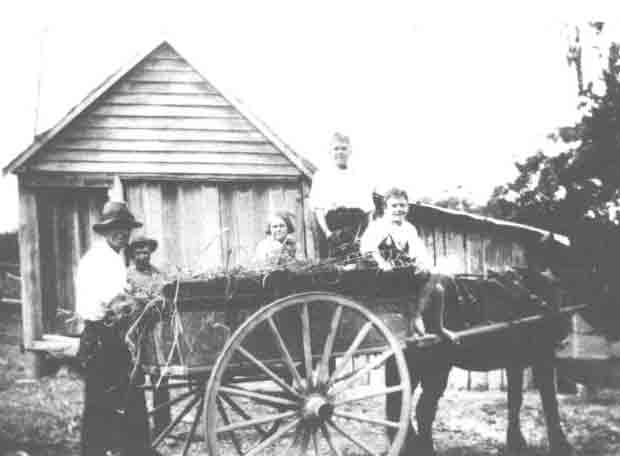
A Common means of Transport. Photo courtesy of M Cooper.
|
|
|
The Move to Grandview
The restumped schoolhouse capped by
a new tin roof was ready for occupation on 5 October 1906. Twenty-eight
children were enrolled at the new provisional school under the tutelage of
Headmaster Richard Hilton. In 1908 the Board agreed to relocate the teacher's
residence to the new site. Removal and building extensions were carried out by
J. Price for 288 pounds.
Names appearing on the school
committee over the next ten years included Robert Bainbridge, James and William
O'Brien, John Bird Snr and William Denniston. Members continued to ensure the
buildings and grounds were maintained.
School work still focussed on the
3Rs but a shift towards useful subjects saw the introduction of nature studies
which included aspects of agriculture and biology. Drill, gymnastics and vocal
music were also part of the curriculum, but were oftern ignored or poorly
taught. The school day lasted from 9am to 4pm with a one or two hour break.
Cricket, swimming in the creek and wandering the neighbouring paddocks were
popular midday activities.
The District Inspector was obviously
impressed with the children's progress, commenting in his report of August
1907:
"Fully over half of the school
is comprised of pupils older than one generally finds in bush schools. The
whole are very well behaved, and give little trouble, but quietly, and
self-reliantly, apply themselves... I have seldom seen bigger boys more anxious
to make up for lost time."
Headmaster's residence. Photo courtesy of PEEC.
In 1909 four year old John Bird
began a lifelong association with the local school. He was awarded a special
medal for not missing a single day during the eight years of his primary
education.Pullen Vale regained its state school status in about 1909 when
minimum enrolment requirements had been reduced to twelve. The school's
population received an unexpected boost in 1912 with the enrolment of 27
trenchers' children. For three months, labourers, digging the trenches for the
water pipeline between Mt Crosby and Kenmore, camped at Pullen Vale with their
families.
The pipeline also boosted the local
economy with farmers selling food to the trenchers and employment for people,
such as Tom Currie who hauled pipes with his bullock team.
By 1914 the school picnic had become
an annual event. The school was closed for the day and parents with trucks
would load up families and head off to Moreton Bay for a seaside picnic and
cruise on the "Koopa". the Brisbane Exhibition and Brookfield Show
were other special events that warranted official time off school.
The school, though far removed from
the battlefields, did not escape the effects of World War 1. One of its former
students, Patrick Boyle, was taken prisoner during his four year enlistment. On
Armistice Day 1918 Headmaster Gall and the students celebrated the end of the
war by banging tin cans and anything else they could find.
Through Depression and War
The social fabric of Pullen Vale
remained intact through the economic and emotional stress of the Great
Depression and World War II. Most families were not wealthy, but they were
self-sufficient. The valley not only maintained its commercially viable dairies
and tropical fruit farms but also boasted the largest pineapple plantation in
the southern hemisphere.
Living conditions were basic by
today's standards. There was no electricity or tap water and roads were little
more than rough, dirt tracks. Motor vehicles were uncommon and bullock teams
still hauled timber down Grandview Road from Moggill Forest.
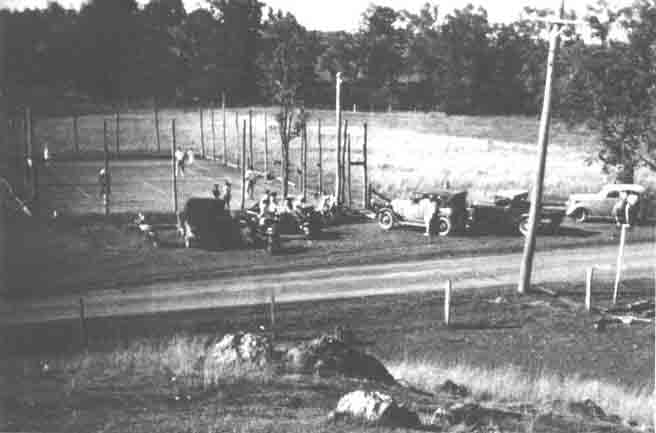
Tennis at the O'Brien's. Photo courtesy of M.Cooper.
The Post Office on Grandview Road
was the local meeting place. Mail arrived by horse and sulky. When Denniston,
who took over from Jessie Fisher, had a telephone installed, he would yell out
messages across the paddocks. In the 1940s, people would meet at the post
Office to catch the twice weekly bus into the city.
Weekend cricket matches also drew
the locals together. Roy Else recalls matches played at his uncle Tom Else's
property and that Billy Anstead had a reputation as a fast bowler. Spectators
sat under a big fig tree above the pitch where teams from Brookfield, Moggill
and Fig Tree Pocket would take on the Pullen Vale Stringybarkers. Tennis was
another social magnet attracting players from the O'Brien, Boyle, Mackay,
Anstead, O'Reilly, Else and Gillingwater families. Games were held on the
O'Brien's court where the pony club is sited. In 1920 Headmaster McWilliam
recommended the Pullen Vale Tennis Club be allowed to construct a court at the
school as it would help promote social life and friendliness in the district. Occasionally, the headmaster or committee
would organise a Saturday night dance at the school. It later became a regular
event held in a pineapple packing shed on the Pullenvale Hall site. These rowdy
affairs were emceed by Tom Else and the Currie family provided live music.
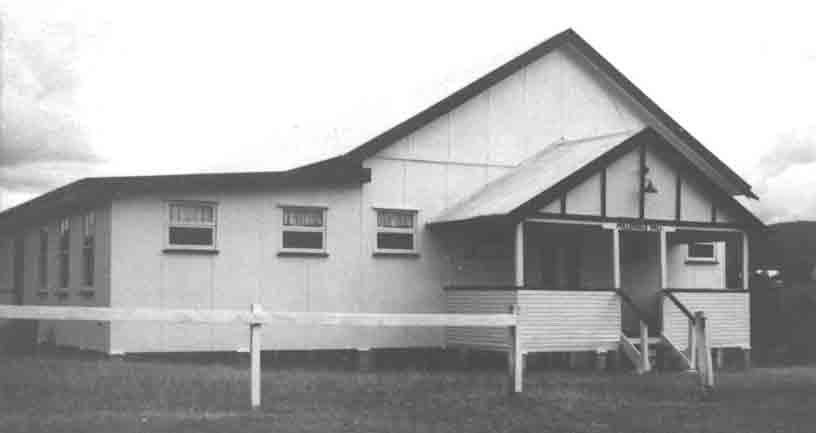
Pullenvale Hall. Photo courtesy of C. Jones.
By the 1920s Pullen Vale State
School was echoing with the voices of the pioneers' grandchildren. The
headmaster presided from a cane-bottomed chair behind a four foot desk. At his
disposal were two blackboards, two easels and a library housed by one wall
cabinet and three shelves. The children sat eight to a row at long, pine desks.
The school was unheated in winter
and former students Marie Cooper (nee Boyle) and Ronnie Mair (nee O'Reilly)
recall cold draughts rising through large gaps between the floorboards. Drill
squad, physical exercises and organised games were held on the tennis court
between the school and teacher's residence. The headmaster's wife usually took
needlework classes and a Catholic priest conducted weekly religious
The Department of Public Instruction
introduced the Agricultural Project Club scheme during this era in an attempt
to link educational activities with rural home life. Milk and cream testing
were a part of the Years 4 and 5 curriculum by 1923. The children were also
encouraged to tend a garden plot or raise a calf or poultry, recording their
progress in workbooks.
The scheme flourished under the
guidance of Headmaster George Oakden and parents, such as John O'Reilly. The children's
efforts culminated in the annual Project Club Day when they gave speeches and
demonstrations and their animals were judged by an officer from Department of
Agriculture and Stock.
The school committee continued to
look after the grounds and buildings through this period. In 1925 the closets
were converted from 'long drops' to a pan system, although it seems someone
forgot to organise the night soil collection. Two years later the committee
line the schoolroom ceiling and walls and enclosed part of the verandah. Public
funding for schools was scarce in the 1930s and the committee's efforts to
lobby the department and politicians for further improvements were
unsuccessful.
Tensions within the committee led to
the resignation of five of its seven members in 1936 and Oakden recommended it
not be replaced. It appears there was no formal community representation until
the formation of a Parents' Welfare Association in 1944.
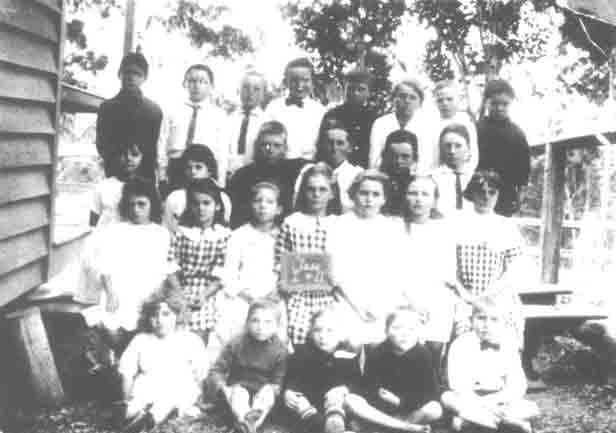
Classes I & II, 1928. Photo courtesy of PEEC.
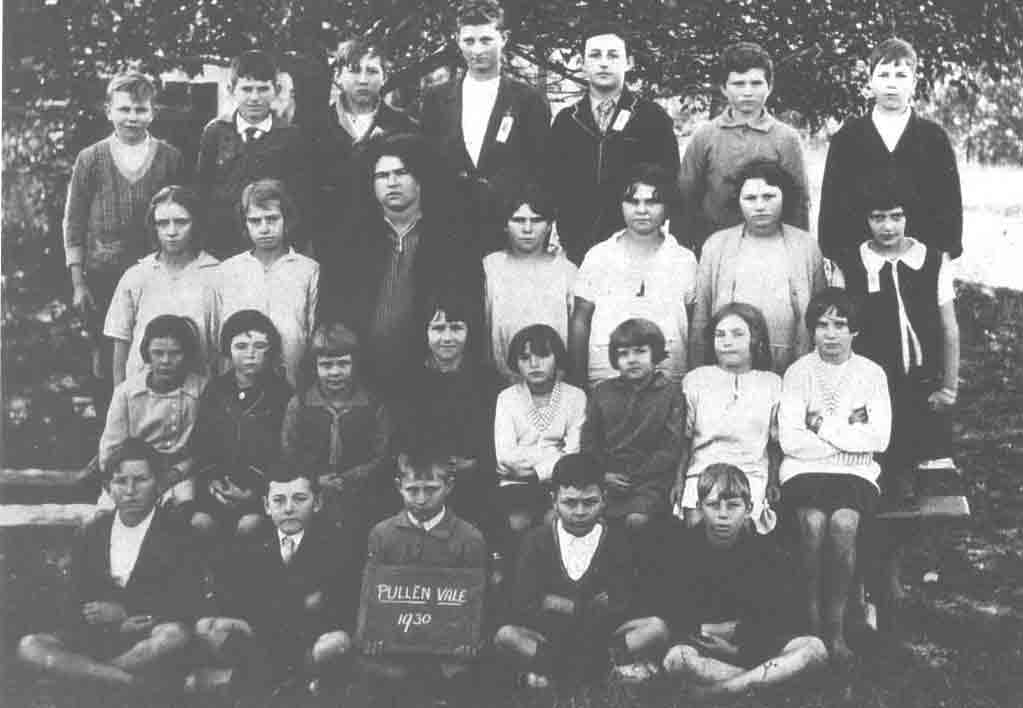
Students of 1930. Photo courtesy of V.Mair.
From Rural to Suburban
In the 30
years following World War II the valley underwent a gradual transformation from
large rural properties to small acreage homesites. By the early 1970s
subdivisions of 2.5 and 5 acres had replaced the 10 and 20 acre portions common
in the 1960s. Local use of the one word spelling for Pullenvale gained official
recognition in about 1970 when the suburbs of Bellbowrie, Anstead and Pinjarra
Hills were created.
While the
district was changing, the one-room schoolhouse on Grandview Road retained its
rural atmosphere until the late 70s. This was due in part to a post war
expansion of the state's secondary education system and the government's
reluctance to spend money on primary schools.
Lionel
Dittman, principal from 1962-67, recalls possums in the ceiling disrupting
classes, and getting fresh milk daily in a billycan from John Bird. Mr Bird
also made financial contributions to the school during this era.
Doug
Woodward, who joined his siblings at the school in 1959, remembers walking to
school barefoot through the paddocks with the Mackay children. Lunchtime
pursuits included Red Rover, rounders and sneaking down to the creek for a
swim.
Departmental
statistics indicate annual enrolments varied between 20 and 40 students from
1950 to 1963. During this time the school had groomed several final year
students to sit the scholarship examination. The exam was abolished in 1963
with the introduction of free secondary schooling.
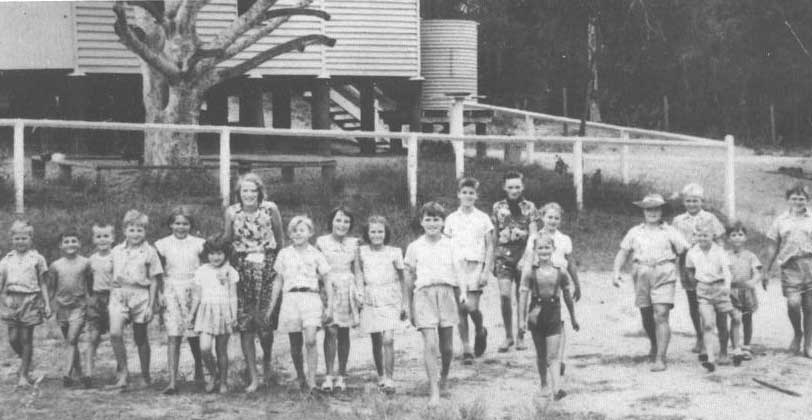
Pupils of 1961. Photo courtesy of J.Duke.
An alarming
drop in student numbers during the mid 60s saw some parents registering their
four-year olds to keep the school open, just as Thomas Herron had done in 1875.
Even with the addition of the principal's children, there were only 10 pupils
on the roll in 1966.
Students
enjoyed the benefits of a family atmosphere and a more flexible approach to
structured learning which came with the State Education Act of 1964. They
participated in a range of activities including swimming lessons at Jindalee
and interschool garden and sport competitions. No doubt the boys also
appreciated an officially sanctioned end to caning. About this time a big
Christmas party at Bundaleer replaced the annual seaside picnic. There were
races and iceblocks and each child received a book from P&C funds.
Project Club
activities continues at the school. Students elected office bearers and gave
talks during formal meetings. Athol Alcorn helped the club raise funds by
selling live carpet snakes at two shillings per foot to university researchers.
One hundred
years after Pullen Vale State School opened, Cecil Pellatt was the principal of
the last one-teacher school in the greater Brisbane region. An estimated 871
children had been registered at the school from 1874-1974.
Centenary Year 1974. Photo courtesy of PEEC.
Past
principal Geoff Lacey offers memories of Pullenvale from the mid to late 1970s:
"When I
arrived in 1975, the school had only 13 students and walking into it was like
taking a step back in the past. The gentlemanly Cec Pellatt had been there for
many years and the respect he held in the district was well earned. His wife
used to take the girls for needlework and other traditional crafts on a Friday
afternoon.
The weeks I
spent with Cec just prior to and after my appointment gave me a wonderful
opportunity to temper my youthful enthusiasm with a firm belief in and
commitment to the history of the school, and its strong, supportive community.
The local
families - both the established and the 'Johnny-come-lately' (those who hadn't
been there for at least two generations) were welcoming, committed to an
all-round education for their children and fiercely proud of their little
school.
My wife
Rosemary and I found living in the residence a wonderful mixture of tradition
with suburban convenience. The enormous carpet snake draped over the verandah
rafters, the wallabies on the oval around dusk, possums in the ceiling and the
jonquils that grew wild on the marshy lower side of the house were all part and
parcel of the wonderful environment.
The Brahman
calves, the sheep, goats, ducks, geese, chooks, bees and vegetable garden
caused much bureaucratic head shaking, but reinforced that rural nature of the
school. Inside we operated a family grouping system with the older children
working with their younger counterparts. The school dances and socials at the
hall were great fun."
Enrolments
had escalated to 60 by the beginning of 1979. Parents and successive principals
had been lobbying the Education Department for some years to develop the nine
acre site it had purchased in 1970 from John Bird. Its response was to erect
demountable classrooms either side of the old schoolhouse. Meanwhile parents
had been mowing and landscaping the new site so students would have space for
sporting activities.
In April
1980 the Minister advised that a replacement school for Pullenvale had been
given top priority subject to funding. Preliminary estimates put the cost at
$437 000.
It was
obvious before construction even began that the combined administrative and
teaching unit and the separate amenities block would not accommodate the 93
students erected for 1981. The department rejected these concerns stating that
the existing demountables were available if necessary.
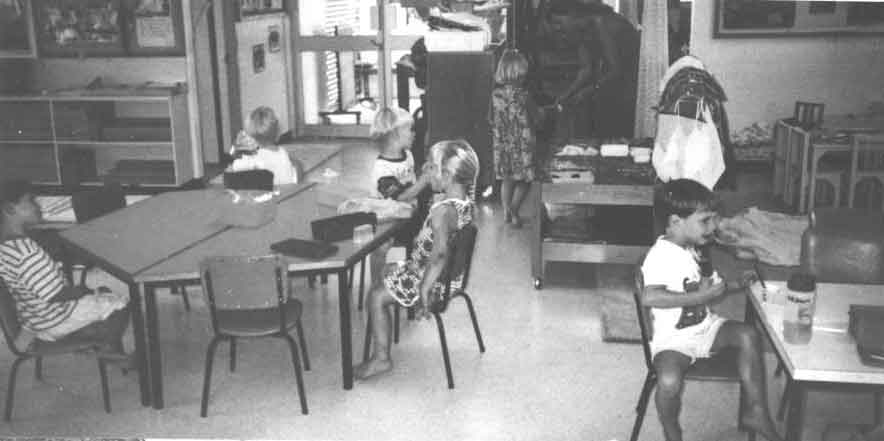
Lunch in the Preschool 1974
A New Era
Past
principal John Kelly recalls the transition to the new school in 1981:
"I was
the last Principal on the old site and the first one on the new site. It was a
time of long days and short nights for me. During my three years, I was blessed
with a top quality staff and an enthusiastic and supportive Parents and
Citizens Association.
The students
were particularly fond of the history of the old school and were proud of their
gardens, self-made paths and favourite trees and birds. It was a truly peaceful
setting. This peace pervaded the student and teacher community only to be
occasionally upset by loud screams of terror coming from the girl's toilet.
Those wonderful green frogs had returned.
It was a
sombre feeling experienced by all during the last days at the old site, yet
there also existed a sense of anticipation as we planned to occupy the flash
new buildings and spacious grounds.
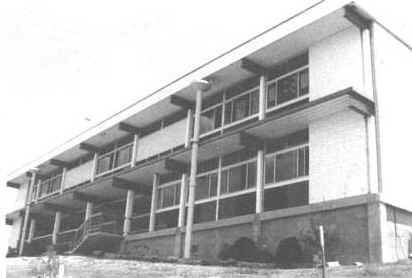
Teaching and Admin Block, 1981.
Our first
day on the big grounds was remarkable. The 80 students were so accustomed to
playing on such a small area that it took two lunch hours before they ventured
far from the main building. On the third day they spread so far that we had to
sit together and work out the in and out of bounds areas."
In January
1982, Val Fawcett replaced John Kelly as Principal and recalls:
"There
were not may female principals in those days and it was with mixed feelings of
excitement and some trepidation that I made my first visit during a P&C working
bee one Saturday afternoon.
The school
building was quite new. All the classrooms were in one teaching block with the
undercover play area below. The gardens had been put in place and maintained by
dedicated parents and a couple of enthusiastic Upper Grade boys. However, the
oval was in the very early stages of being developed and 1982 became 'The Year
of the Mower'."
With Bill
Millis' four and a half year stewardship came a school choir, interhouse
athletics carnival, the reintroduction of interschool sports and the opening of
the preschool. Bill still vividly remembers:
"Penny Everingham and Joanne Byrne rehearsing students for the theatre restaurants
· Gerald Brown always assisting and the Strakers always helping
· Sue Meeking pouring over the accounts
· The Arts and Craft nights, fetes and Billy Boiling days
· the Project Club days - extracting honey and visiting home gardens
· the Year 7 dinner nights and the awarding of the Trotter Prize."
The Pullenvale State Preschool opened in 1986 with Elaine Simpkins as its first
teacher. The centre operated a two and a half hour session for a small group of
children until December 1995 when the Department approved a full day program.
Over the past twelve years the efforts of a dedicated staff and Parents' Group
have resulted in a well equipped, multi-faceted learning centre which focuses
on the preparation of children for their primary education.
Sue
Meeking's reminiscences as a parent and staff member provide a valuable
overview of the school through the 1980s"
"It was
with much interest we observed the progress of the new school building as we
drove past each day to the old school. Finally the day arrived in April 1981
when the students and staff could relocate to the new building with all the
acres of grass surrounding it.
Working bees
of parents, friends and children set about maintaining the grounds. Parents
came at weekends with their ride-on mowers, brushcutters and tools to start the
long process of establishing an oval and shady aras. No groundsman was employed
at that time.
In 1981
Pullenvale State School dedicated its oval to Mr John Bird in recognition of
his many contributions to the school. Year 7 student Nick Petroeschevsky spoke
of the students' appreciation in his maiden speech as Pullenvale's first school
captain.
Views from the oval.
A band of
mothers, accompanied by toddlers, continued to nurture many small trees and
help establish shade houses. In 1982, the P&C had to raise 50% of the cost
of a tractor for grounds maintenance - a big effort for a small school
community - and the parents were rostered for weekend mowing.
It was
during this time a competition was held to design a school logo for the
unofficial uniform of gold t-shirt and black shorts or skirt. Parents and other
community members submitted designs and the koala emblem was selected.
By 1984 the
school population had reached 127 and a demountable was positioned between
Teaching Block 1 and the lower carpark.
Over the
years, excursions, camps and interschool sport have provided many wonderful
memories for students, parents and staff. Mr Bill Millis, Principal from
1983-1987, purchased tents for overnight camps on the school oval and at Moreton
Island.
Sports
including cricket, softball, Australian Rules, netball, tennis and soccer
provided students with opportunities to develop their skills and learn the art
of good sportsmanship.
The students
were divided into House groups for athletic competitions. Captains and Vice
Captains of the Pullen and Vale Houses were elected and acted as school leaders
at functions and sporting events. Local MP at the time, Mr Bill Lickiss,
donated the Lickiss Shield for interhouse athletics competitions.
During the
1980s, the school community held many fund-raisers that helped build a very
supportive and strong school spirit. Pullenvale Country Fairs and Arts &
Crafts Shows were well supported and offered an opportunity for the community
to make new acquaintances and catch up with old ones. The Billy Boiling
Competitions attracted challengers from far and wide and qualified for the
Guinness Book of Records."
The Pullenvale Environmental Education Centre
This centre
is located in Grandview Road. The old school building at the front of the
centre was the former Pullenvale State School. Students from our school, along
with thousands of students throughout Queensland, attend this school for
excursions and workshops throughout the year.